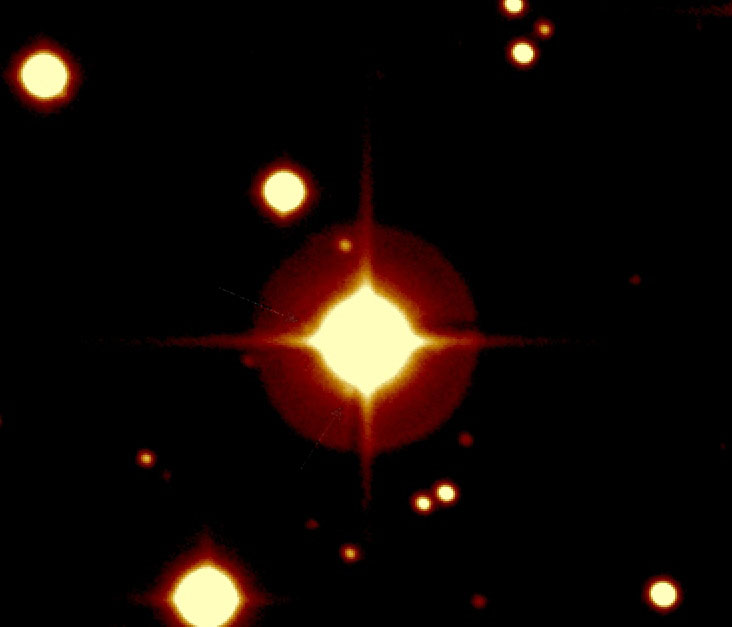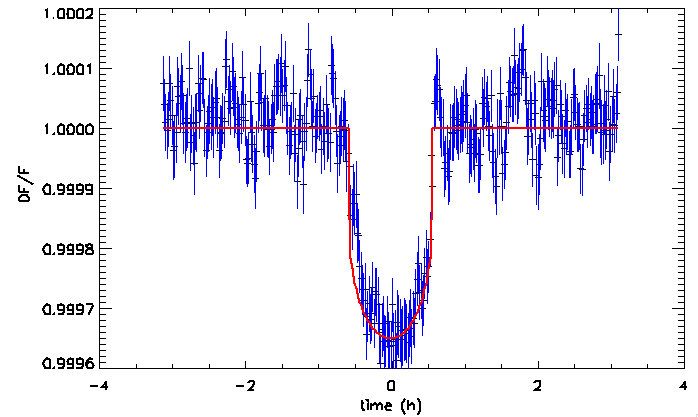The CoRoT satellite, developed by CNES, has allowed the discovery of the smallest exoplanet ever characterized, of a size comparable to that of the Earth. Most of the some 330 planets discovered so far are giant planets made up mostly of gas, like Jupiter and Neptune. This new object, named CoRoT-Exo-7b, is very different : its diameter is only 1.8 that of the Earth. With a revolution period or "year" of only 20 hours, it is located very close to its primary star, so that its temperature is extremely high, between 1,000 and 1,500 degrees Celsius. Astronomers were able to detect the new planet by the very slight dimming of the star that occurs at regular intervals, each time the planet passes in front of it. Its density has not yet been well determined : it could be a rocky object like the Eart or covered with liquid lava or with supercritically pressurized hot water under a dense atmosphere. In any case it will be a new type of terrestrial planets that needs further investigation. In that case, it would be a "sauna planet" , considering its extremely high temperature.

"Finding such a small planet wasn’t a complete surprise" , says Daniel Rouan, researcher from LESIA at the Observatoire de Paris, who coordinates the project together with Alain Léger, from IAS. "CoRoT-Exo-7b belongs to a class of objects whose existence had been conjectured for some time. Now, CoRoT was designed precisely in the hope of discovering some of these objects. CoRoT has proved it can detect those extremely subtle variations in light," he adds.
Astronomers have been detecting planets orbiting around stars for some fifteen years. Today, over 330 are known, most of them quite large, with up to twenty times the mass of Jupiter. But very few have a mass comparable to that of the Earth and the other terrestrial planets (Venus, Mars, and Mercury) because they are extremely difficult to detect. "Most of the methods used so far are sensitive to the mass of the planet, while CoRoT is sensitive to its size, which is an advantage," explain Roi Alonso and Magali Deleuil, researchers at LAM. "Another of CoRot’s advantages is the fact of being in space, where disturbances are much smaller and the period of uninterrupted observation much longer than from the ground," adds Hans Deeg, a member of the scientific team and a researcher at the Canary Islands Astrophysics Institute.

The internal structure of CoRoT-Exo-7b particularly puzzles scientists. "It is a question that has attracted the attention of the astronomical community for several years : Are there also "ocean planets" ? These would be objects originally half composed of ice that would have drifted towards their star, the ice then melting to form a fluid envelope," says Alain Léger.
Jean Schneider, a researcher from the Laboratory Universe and Theories at the Observatoire de Paris, explains the significance of this new object for planet hunters : "Recent measurements indicated the existence of planets of small mass but their size had never been determined. This has now been done."
Eike Guenther, from the Tautenburg Observatory observes that "this program benefited from a significant number of complementary measurements from the ground : many European telescopes and instruments were called upon to determine what phenomenon other than a small planet could explain CoRoT’s data." "This monitoring phase was an essential, meticulous one," concludes Daniel Rouan," which is the reason why this result is only being announced now. You can easily imagine our excitement every time a new measurement came out and didn’t invalidate our hypothesis !"

This discovery benefited from complementary observations made thanks to an extensive European telescope network operated by various institutes and countries. The European Southern Observatory at Paranal and La Silla (Chile), several telescopes at the Canary Islands Astrophysics Institute, and the Canada-France-Hawaii Telescope on Mauna Kea, Hawaii (CNRS, CNRC, and University of Hawaii).
CoRoT in short
The CoRoT satellite was developed by a CNES integrated team and laboratories associated to CNRS, the principal ones being the Laboratory for Space Studies and Astrophysics Instrumentation (Observatoire de Paris), the Marseille Astrophysics Laboratory (Marseille-Provence Astronomical Observatory), Institute of Space Astrophysics, Orsay (University Paris-Sud 11), and the Midi Pyrénées Observatory, Toulouse (INSU). The project also benefited from an important European participation (Austria, Belgium, ESA, Germany, and Spain) together with that of Brazil. CoRoT — for (stellar) Convection, Rotation & (planetary) Transits — is a telescope placed in orbit around the Earth in late 2006. It was designed to detect tiny variations in the luminosity of stars. The instrument has two scientific goals : — the search for planets orbiting stars other than our Sun and in particular planets similar to the Earth ; — the detection of star vibrations in order to determine their composition (stellar seismology).
